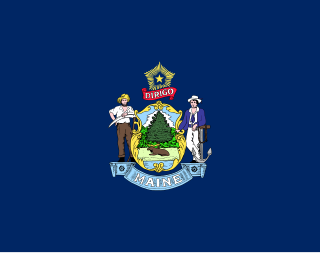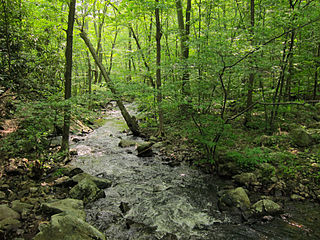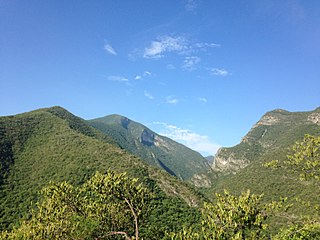The Central Appalachian dry oak-pine forest is a forest system found from Maine south through New Hampshire, Vermont, Massachusetts, Rhode Island, Connecticut, New York, New Jersey, Pennsylvania, Maryland, to West Virginia and Virginia. It is abundant in the low- and mid-elevation central Appalachian Mountains and in the central Piedmont.

Maine is a state in the New England region of the northeastern United States. Maine is the 12th smallest by area, the 9th least populous, and the 38th most densely populated of the 50 U.S. states. It is bordered by New Hampshire to the west, the Atlantic Ocean to the southeast, and the Canadian provinces of New Brunswick and Quebec to the northeast and northwest respectively. Maine is the easternmost state in the contiguous United States, and the northernmost state east of the Great Lakes. It is known for its jagged, rocky coastline; low, rolling mountains; heavily forested interior; and picturesque waterways, as well as its seafood cuisine, especially lobster and clams. There is a humid continental climate throughout most of the state, including in coastal areas such as its most populous city of Portland. The capital is Augusta.

New Hampshire is a state in the New England region of the northeastern United States. It is bordered by Massachusetts to the south, Vermont to the west, Maine and the Atlantic Ocean to the east, and the Canadian province of Quebec to the north. New Hampshire is the 5th smallest by area and the 10th least populous of the 50 states. Concord is the state capital, while Manchester is the largest city in the state. It has no general sales tax, nor is personal income taxed at either the state or local level. The New Hampshire primary is the first primary in the U.S. presidential election cycle. Its license plates carry the state motto, "Live Free or Die". The state's nickname, "The Granite State", refers to its extensive granite formations and quarries.

Vermont is a state in the New England region of the northeastern United States. It borders the U.S. states of Massachusetts to the south, New Hampshire to the east, New York to the west, and the Canadian province of Quebec to the north. Vermont is the second-smallest by population and the sixth-smallest by area of the 50 U.S. states. The state capital is Montpelier, the least populous state capital in the United States. The most populous city, Burlington, is the least populous city to be the most populous city in a state. As of 2015, Vermont was the leading producer of maple syrup in the United States. In crime statistics, it was ranked as the safest state in the country in 2016.
These forests occur on dry sites with loamy to sandy soils. A mix of oak and pine tree species dominate the canopy, typically chestnut oak ( Quercus prinus ), Virginia pine ( Pinus virginiana ), and white pine ( Pinus strobus ), but sometimes white oak ( Quercus alba ) or scarlet oak ( Quercus coccinea ). Varying amounts of oaks and pines result in oak forests, mixed oak-pine forests, or small pine forests. Shrubs such as hillside blueberry ( Vaccinium pallidum ), black huckleberry ( Gaylussacia baccata ), and mountain laurel ( Kalmia latifolia ) are common in the understory and can form a dense layer. [1] [2]

In biology, the canopy is the aboveground portion of a plant community or crop, formed by the collection of individual plant crowns.

Pinus virginiana, the Virginia pine, scrub pine, Jersey pine, is a medium-sized tree, often found on poorer soils from Long Island in southern New York south through the Appalachian Mountains to western Tennessee and Alabama. The usual size range for this pine is 9–18 m, but can grow taller under optimum conditions. The trunk can be as large as 0.5 m diameter. This tree prefers well-drained loam or clay, but will also grow on very poor, sandy soil, where it remains small and stunted. The typical life span is 65 to 90 years.

Pinus strobus, commonly denominated the eastern white pine, northern white pine, white pine, Weymouth pine (British), and soft pine is a large pine native to eastern North America. It occurs from Newfoundland, Canada west through the Great Lakes region to southeastern Manitoba and Minnesota, United States, and south along the Appalachian Mountains and upper Piedmont to northernmost Georgia and perhaps very rarely in some of the higher elevations in northeastern Alabama.
This system is found on drier sites than the related Northeastern interior dry-mesic oak forest. South of central Virginia, it is replaced by the Southern Piedmont dry oak-pine forest. [1]
The Northeastern interior dry-mesic oak forest is a forest system found in Maine, Vermont, New Hampshire, Massachusetts, Connecticut, Rhode Island, New York, New Jersey, Ohio, Pennsylvania, Maryland, Virginia, and West Virginia. These forests cover large areas at low and middle elevations, typically on flat to gently rolling terrain.












